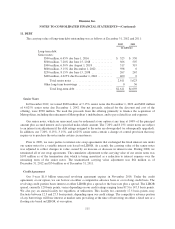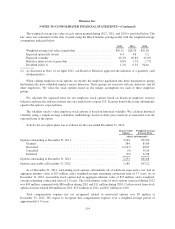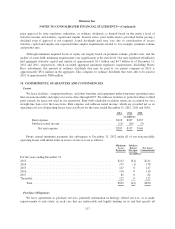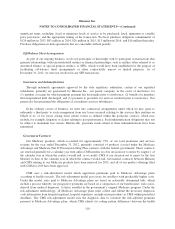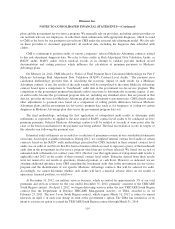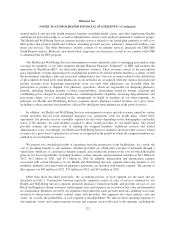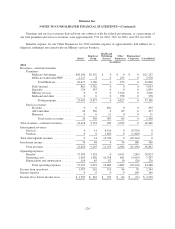Humana 2012 Annual Report Download - page 131
Download and view the complete annual report
Please find page 131 of the 2012 Humana annual report below. You can navigate through the pages in the report by either clicking on the pages listed below, or by using the keyword search tool below to find specific information within the annual report.Humana Inc.
NOTES TO CONSOLIDATED FINANCIAL STATEMENTS—(Continued)
provider arrangements, general contractual matters, intellectual property matters, and challenges to subrogation
practices. Under state guaranty assessment laws, we may be assessed (up to prescribed limits) for certain
obligations to the policyholders and claimants of insolvent insurance companies that write the same line or lines
of business as we do. As a government contractor, we may also be subject to qui tam litigation brought by
individuals who seek to sue on behalf of the government, alleging that the government contractor submitted false
claims to the government including, among other allegations, resulting from coding and review practices under
the Medicare risk-adjustment model. Qui tam litigation is filed under seal to allow the government an
opportunity to investigate and to decide if it wishes to intervene and assume control of the litigation. If the
government does not intervene, the lawsuit is unsealed, and the individual may continue to prosecute the action
on his or her own. We also are subject to allegations of non-performance of contractual obligations to providers,
members, and others, including failure to properly pay claims, improper policy terminations, challenges to our
implementation of the Medicare Part D prescription drug program and other litigation.
Personal injury claims and claims for extracontractual damages arising from medical benefit denials are
covered by insurance from our wholly owned captive insurance subsidiary and excess carriers, except to the
extent that claimants seek punitive damages, which may not be covered by insurance in certain states in which
insurance coverage for punitive damages is not permitted. In addition, insurance coverage for all or certain forms
of liability has become increasingly costly and may become unavailable or prohibitively expensive in the future.
We record accruals for such contingencies to the extent that we conclude it is probable that a liability has
been incurred and the amount of the loss can be reasonably estimated. No estimate of the possible loss or range
of loss in excess of amounts accrued, if any, can be made at this time regarding the matters specifically described
above because of the inherently unpredictable nature of legal proceedings, which also may be exacerbated by
various factors, including: (i) the damages sought in the proceedings are unsubstantiated or indeterminate;
(ii) discovery is not complete; (iii) the proceeding is in its early stages; (iv) the matters present legal
uncertainties; (v) there are significant facts in dispute; (vi) there are a large number of parties (including where it
is uncertain how liability, if any, will be shared among multiple defendants); or (vii) there is a wide range of
potential outcomes.
The outcome of any current or future litigation or governmental or internal investigations, including the
matters described above, cannot be accurately predicted, nor can we predict any resulting penalties, fines or other
sanctions that may be imposed at the discretion of federal or state regulatory authorities. Nevertheless, it is
reasonably possible that any such outcome of litigation, penalties, fines or other sanctions could be substantial,
and the outcome of these matters may have a material adverse effect on our results of operations, financial
position, and cash flows, and may also affect our reputation.
16. SEGMENT INFORMATION
We manage our business with three reportable segments: Retail, Employer Group, and Health and Well-
Being Services. In addition, the Other Businesses category includes businesses that are not individually
reportable because they do not meet the quantitative thresholds required by generally accepted accounting
principles. These segments are based on a combination of the type of health plan customer and adjacent
businesses centered on well-being solutions for our health plans and other customers, as described below. These
segment groupings are consistent with information used by our Chief Executive Officer to assess performance
and allocate resources.
The Retail segment consists of Medicare and commercial fully-insured medical and specialty health
insurance benefits, including dental, vision, and other supplemental health and financial protection products,
marketed directly to individuals. The Employer Group segment consists of Medicare and commercial fully-
121


